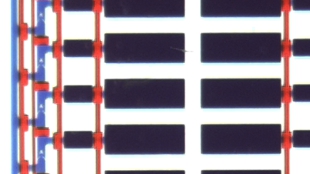 The single-cell RT-qPCR microfluidic chipCARL HANSEN
The single-cell RT-qPCR microfluidic chipCARL HANSEN
THE DEVICE: Like a pinball machine, the tiny stationary levers within this new microfluidics chip, direct cells into compartments just large enough to fit one cell. With 300 compartments per chip (a number that could be easily scaled to 1,000 or more), each cell is washed and then lysed, with its contents channeled to a new compartment where real time quantitative PCR begins, reading out the DNA as it's amplified. Measuring many individual cells at once allows researcher to distinguish individual differences between cells as they react to environmental changes, or to look at genetic changes in the mixed-cell make-up of a tumor. Down the road, the chip could have clinical and diagnostic applications as well.

WHAT'S NEW: Although researchers had previously shown that it's possible to amplify genes using PCR from single cells, the process was laborious, limiting the number of cells of that could be analyzed at once. Carl Hansen and colleagues at the University of British Columbia in Vancouver designed a chip that overcomes these limitation by streamlining the "movement of cells into a capture pocket,” said Samuel Kim, a Stanford University postdoctoral researcher who was not involved in the research. The pinball levers focus the flow of the cell suspension into each cell chamber, and because the pockets are just big enough to fit one cell, the next cell simply passes by, and pings into the next empty chamber. With almost 100 percent efficiency, "it ensures single cell capture per chamber," said Kim, who studies microfluidics in Richard Zare's lab at Stanford.
But figuring out the right size for the chambers was no simple task. The size had to be just right, not only in order to catch the majority of cell types (unusually large or small cells won't fit), but also to create the right ratio cell matter to PCR reagents. While a higher ratio of starting material to reagent is better for improving the precision of detection, when working with picoliter volumes, if "the concentration of the cell is too high," said Hansen, "you poison the reaction."
Another benefit of the chip is that it "nicely makes it possible to clean up cells" said Kim. Prior to being lysed and funneled into the PCR reaction, the cells must be cleaned to ensure that only the DNA or RNA of the captured cell is amplified, rather than residual DNA from other sources. The new chip conveniently incorporates this step into its processes.
 Close up of a cell-capture and RT PCR chambersADAM WHITE
Close up of a cell-capture and RT PCR chambersADAM WHITEIMPORTANCE: "This all stems from a general problem in biological research," said Hansen. "Most of the existing technologies have been limited to the analysis of mixtures of cells," because larger quantities of starting material are needed for detection. The drawback of studying cell mechanisms by aggregate is that even cells with the same genomes can have different reactions to the same stimuli. Rather than detecting these subtle differences, aggregate measurements only pick up the average or most prevalent response.
Already, Hansen and his collaborators have used the chip to read microRNA expression in a variety of cell types including a cell line derived from leukemia and in embryonic stem cells during differentiation. They also used the chip to identify single nucleotide variants in a gene suspected to alter metastatic potential of a breast-cancer patient sample.
Though the most obvious use of this technology is in basic research, clinicians could also find such a chip useful, Hansen said. Though no research has demonstrated that single cell measurements can improve the diagnosis of a disease, he said, detecting mutations in a heterogeneous mixture of tumor cells, some of which may confer drug resistance, could help clinicians decide how to treat the cancer. Currently Hansen is collaborating with Fluidigm Corporation, which develops and sells a microfluidic chips for a number of applications, to further develop the chip.
NEEDS IMPROVEMENT: While the chip gives researchers a new way to study large numbers of individual cells, it can currently only detect one to two genes per cell, said Hansen. Measuring 10 or more genes—using multiplex PCR—could give researcher a better sense of the individual gene signature of a cell.
Furthermore, the current chip uses real time PCR, which incorporates fluorescently tagged nucleotides after each cycle of PCR replication, requiring a large and sensitive optical reader "The next obvious step would be to get rid of fluorescence detection (go to electronic detection) so it can be made cheaper and more portable," Albert Folch of the University of Washington, who did not participate in the research, said in an email, by replacing the fluorescence detection with an electronically-read microarray chip, for example.
Because the innovation is being explored as a potential product by Fluidigm, no price has been set. But as far at the cost of the reagents goes, Hansen said that it would cost the same amount to run an entire chip of 300 cells as it would to do a single cell analysis in a tube.
A. K. White et al., "High-throughput microfluidic single-cell RT-qPCR," PNAS, doi: 10.1073/pnas.1019446108, 2011.



